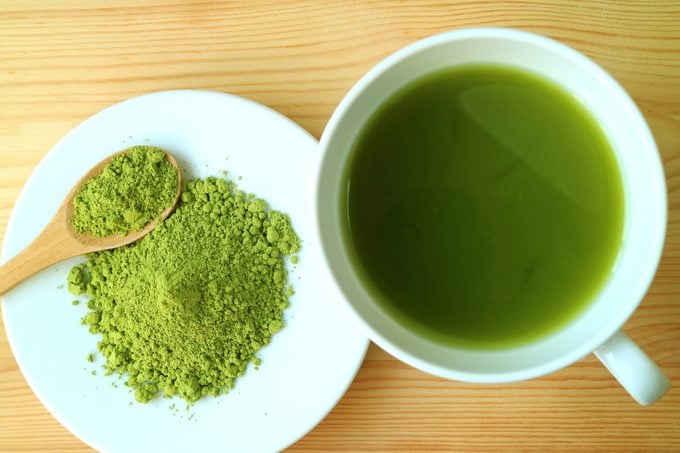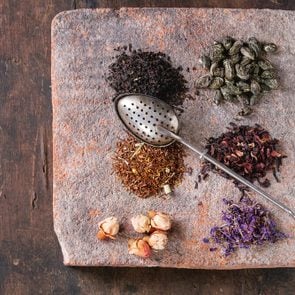Do You Know the Real Differences Between Matcha and Green Tea?
Updated: May 13, 2021
Matcha comes from the same plant as other green teas, but there are a few key distinctions in the way it's grown and produced—and the health benefits.
Matcha vs. green tea
Green tea is one of the most popular drinks consumed worldwide, and it’s not hard to understand why. It can offer a unique mix of stimulation and relaxation, with a light, floral taste, and it’s increasingly renowned for its potential health benefits.
The global green tea market was valued at $12.8 billion in 2019, according to a 2020 report by Fortune Business Insights, and it’s projected to reach $23.66 billion by 2027.
“I think people are looking for ways to improve health and also de-stress,” says Neva Cochran, a registered dietitian and nutrition communications consultant based in Dallas.
“Tea, especially green tea, seems to have a health ‘halo’ and is perceived as a drink that can promote health and reduce risk of disease. It is also viewed as a beverage that is relaxing, whether it is in a traditional English tea with sandwiches and sweets or a Japanese tea ceremony.”
(This is what happens to your body when you drink tea daily.)
There are many different kinds of green tea—originating from different parts of the world, harvested at different stages of growth, and processed with different techniques—each with its own qualities and quirks. One particular type, however, boasts a deeper mystique than most: a form of powdered green tea from Japan known as matcha.
Matcha tea comes from the same plant as all other green teas, but there are a few key differences in the way it’s grown and produced, resulting in a remarkably unique drink.
Here is a closer look at the difference between matcha vs. green tea, including their origins, health benefits, and nutrient profile.
What is green tea?
Green tea, like all true tea, is made from leaves and buds of the Camellia sinensis plant, specifically those that haven’t undergone the oxidation processes used to make darker oolong and black teas. Native to China, C. sinensis seeds were first brought to Japan in the 8th century, where a rich tea culture developed alongside that of China.
There are now many varieties of green tea, which is primarily and most famously produced in China and Japan. Although they all come from the same species, they draw unique characteristics from differences such as the climates where they’re grown or how the leaves and buds are harvested and processed.
What is matcha?
The general idea behind matcha also may have originated in China, reportedly introduced to Japan in the 12th century by the Buddhist monk Eisai. It grew deeply embedded in Japanese culture, becoming central to the traditional Japanese tea ceremony.
There are a few important factors that distinguish matcha from other green teas: how the plants are grown, how the leaves are processed, and how the tea itself is made. Tea bushes for matcha are grown in partial shade, prompting the leaves to produce more chlorophyll as a response to lower sunlight levels. This turns the leaves a darker green, increases the concentration of some nutrients, and slightly alters the taste.
Young leaves are hand-picked after growing for just a few weeks, after which they are steamed, de-stemmed, dried, and ground into a powder. This fine, verdant powder can then be whisked with water to make matcha tea.
While most teas are infusions, in which the tea leaves themselves are removed after steeping in hot water, matcha is mixed with water to create a suspension. Not only do the leaves contain more chlorophyll and antioxidants, but they’re also typically consumed with the drink, unlike an infusion.
There are different grades of matcha depending on the time of year it’s harvested. The highest-quality matcha, sometimes called ceremonial grade, is harvested in the spring.

Health benefits of green tea
Green tea has been used for medicinal purposes in China and Japan for thousands of years, and research does point to some potentially major health benefits, albeit with varying levels of certainty.
Caffeine in green tea offers alertness, and research has also linked caffeine to other helpful effects, including a study in the journal Nutrition Bulletin that found an improvement in mood, attention, reaction time, and memory.
Green tea is also high in a diverse group of plant micronutrients known as polyphenols, particularly flavanols, flavandiols, flavonoids, and phenolic acids, which may account for up to 30 percent of the dry weight, per a study in the journal Chinese Medicine. Most of the green tea polyphenols are flavonols, commonly known as catechins, which are found in greater amounts in green tea than in black or oolong.
Studies on animal models suggest green tea catechins can provide some protection from cancer, heart disease, liver damage, and neurological problems, but there is less clear evidence in humans.
“Although many studies have been done on green tea and its extracts,” explains the U.S. National Center for Complementary and Integrative Health (NCCIH), “definite conclusions cannot yet be reached on whether green tea is helpful for most of the purposes for which it is used.”
Studies of green tea and cancer in humans have had inconsistent results, according to the NCCIH.
There is little evidence of any effect on weight loss or weight management, but there are positive signs that daily tea intake, “as part of a healthy habitual dietary pattern, may be associated with lower risks of [cardiovascular disease] and all-cause mortality among adults,” according to a 2020 research review in Advances in Nutrition.
The major polyphenol found in green tea, epigallocatechin-3-gallate (EGCG), has been linked to therapeutic properties such as anti-atherosclerosis, anti-diabetes, anti-inflammatory, and antioxidant effects, according to a 2018 research review. in the Journal of Ethnopharmacology.
(Check out these other benefits of green tea you never knew.)
Health benefits of matcha
Whatever benefits we might get from the polyphenols in traditional green tea, matcha seems to offer magnitudes more.
There are several catechins in green tea, explains Shayna Komar, a registered dietitian who works with the Cancer Wellness Center at Piedmont Hospital in Atlanta, but the most abundant is EGCG.
The concentration of EGCG available from drinking matcha is 137 times greater than the EGCG available from drinking China Green Tea Tips green tea, according to a widely cited study in the Journal of Chromatography A. It’s also at least three times higher than the largest-known value for other green teas.
As Cochran points out, the way matcha is typically consumed makes a big difference in how available these benefits are from the drink itself. “Because you are actually consuming the leaves, the antioxidant content is higher than other teas, and it is a particularly rich source of L-theanine, an amino acid unique to tea,” Cochran says.
“[L-theanine] is linked to mental relaxation and may help fight stress signals,” Komar adds. “And it modifies the effects of caffeine in your body, increasing alertness.”
(Learn about how to try matcha in your skin care routine.)
Matcha vs. green tea: Caffeine content
Along with more chlorophyll and antioxidants, matcha’s caffeine content also tends to be greater than other green tea. The caffeine content in traditional green tea ranges from 11.3 to 24.67 milligrams per gram, Cochran says, while in matcha it’s between 18.9 and 44.4 mg/g.
When consumed as a beverage, up to 8 cups of green tea per day is considered safe for adults, according to the NCCIH. Drinking green tea may be safe during pregnancy and while breastfeeding at up to 6 cups per day (no more than about 300 mg of caffeine), but more than that during pregnancy may be unsafe.
For matcha, Komar recommends 1 to 2 cups per day for health benefits without negative side effects. As with any food or drink, she says, moderation is key.
“Just keep in mind that tea, including matcha, is not a magic bullet,” Cochran adds.
“A bad diet with tea is still a bad diet. Tea does provide important antioxidants that can promote health and potentially reduce the risk of several diseases, but alone it cannot do this. It is the overall nutritional intake and other lifestyle factors like exercise, sleep, not smoking, alcohol in moderation, and stress reduction, as well as your genes, that will influence health over the long term,” he says.
Next, try this matcha smoothie recipe this dietitian loves or these Pistachio Coconut Chews that start with 2 teaspoons of matcha.



















